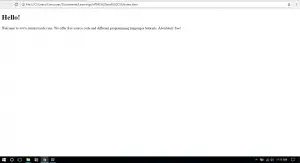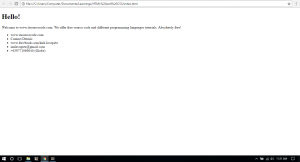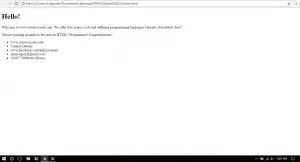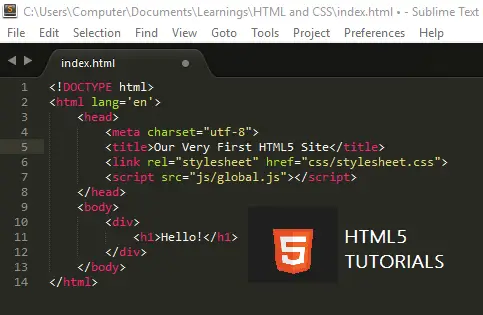New Semantic Elements – Beginners Guide
New Semantic Elements – Beginners Guide.
This tutorial is connected from the second HTML5 tutorial the “First HTML5 Website“.
On the last tutorial, we left off by creating a really basic HTML5 document.
Now, we are going to start filling your first HTML5 document with the new semantic elements. The header, section, footer and aside tags will be discussed on this tutorial.
First, open your index.html file on your Sublime Text Application.
Header tags:
Header tags are like div tags which we will wrap the div tag from the body content of our recent HTML5 document.
<div>
<p>From HTML,</p>
</div>[html5]
<div>
<h1>Hello!</h1>
</div>
[/html5]To <header></header>,
[html5]
<header>
<h1>Hello!</h1>
</header>
[/html5]Header tags will let the browser know that the content with the header tag is the header of your HTML5 document.
Next one, is the section tag. Section is like also a div tag. It groups the content together to tell that this content is related, saying that this content is the section of your website. Add this line of code next to your closing header tag.
[html5]
<section class="main-content">
<p>
Welcome to www.itsourcecode.com. We offer free source code and different programming languages tutorials. Absolutely free!
</p>
</section>
[/html5]Try to run your system to see if it works. See the sample image below for our expected results.

Next, we are going to use the footer tag. Footer tag is the same as the header tag.
Also, the good news are that your browser knows what content is in your footer and this will allow you to prioritize an information whether it is for your Search Engine Optimization or accessibility. Let’s add some details on our footer, insert this line of code under your section end tag.
[html5]
<footer>
<ul>
<li>www.itsourcecode.com</li>
<li>Contact Details:</li>
<li>www.facebook.com/kirk.lavapiez</li>
<li>[email protected]</li>
<li>+639771069640 (Globe)</li>
</ul>
</footer>
[/html5]Footer tag means not only the footer of your page but for the whole HTML5 content.
Here’s our HTML5 website results so far,

Lastly, we are going to use the aside tag. Aside tag is not really your main content but it is more of a secondary content to your main content.
Add this code between your section tag and footer tag.
[html5]
<aside>
<p>
You are gaining grounds to become an HTML5 Programmer! Congratulations!
</p>
</aside>
[/html5]Run again your HTML5 document and you can see that your content are being seperated by header, section, aside and footer tags.

Note, it does let your browser know that this content isn’t as important to your stuff in your main content or other places in your website.
Success! You have successfully learned about the header, section, aside and footer tags. This tags are purely semantic.
Before, every one of these tags are divs and you could not guess what are those contents are but now through HTML5 you can distinguish your content because of these new semantic tags.
On our next tutorial, we will be discussing about Creating Styling Javascript: HTML5 Shiv. Stay tuned webbies!
For questions or any other concerns or thesis/capstone creation with documentation, you can contact me through the following:
RAR Extraction Password:
luffypirates
E-Mail: [email protected]
Facebook: facebook.com/kirk.lavapiez
Contact No.: +639771069640
Ian Hero L. Lavapiez
BSIT Graduate, soon to be MIT.
System Analyst and Developer
To download the sample HTML5 document, click here.
Related topic(s) that you may like:

